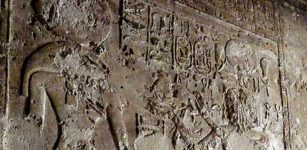Wonderful Long-Lived Nymphs In Greek And Roman Mythologies
A. Sutherland - AncientPages.com - Nymphs (in Greek "nýmphē") were long-lived, wonderful female spirits of the natural world who were invisible to mortals but occasionally could be heard by humans.
But what did these minor goddesses have in common?
They were divided into Oceanids, Nereids, Naiads, Dryads, Hamadryads, and Oreads, and the domain of all of them was a wilderness known to be rarely modified by human activity.
The ocean and the sea were the domain of the Okeanids, the daughters of the Titans Oceanus and Tethys. According to Hesiod's "Theogony," they were parents of six thousand children (three thousand sons, three thousand daughters), the largest single source of nymphs in mythology. The fifty Nereids were offspring of Nereus, an old deity of pre-Olympic origin, and his wife Doris. The Nereids dwelt with their father in the kingdom of the Aegean Sea.
This is a preview of our premium article available only to members of Ancient Pages.
Become a member to read more - Click here
If you are already a member and have logged in to your account, you can access the article here
See also:
Elusive Legendary Mist Witches Who Can Be As Wise As Dangerous
The Curse Fell On King Midas And His Gold Desire Became A Nightmare
Hamingja – Norse Guardian Spirit Bringing Good Luck From Generation To Generation
Explore also: Ancient Pages Library Of Ancient And Unexplained Mysteries
More From Ancient Pages
-
 Ancient Greeks Reached Iceland Before The Vikings – New Theory Suggests
Featured Stories | Dec 10, 2022
Ancient Greeks Reached Iceland Before The Vikings – New Theory Suggests
Featured Stories | Dec 10, 2022 -
 Templo Mayor – Sacred Aztec Complex Dedicated To Gods Tlaloc And Huitzilopochtli Who Were Usually Appeased With Human Sacrifices
Featured Stories | Jan 23, 2018
Templo Mayor – Sacred Aztec Complex Dedicated To Gods Tlaloc And Huitzilopochtli Who Were Usually Appeased With Human Sacrifices
Featured Stories | Jan 23, 2018 -
 Unique Bronze Age Fortress Discovered In Galway, Ireland
Archaeology | Jun 25, 2022
Unique Bronze Age Fortress Discovered In Galway, Ireland
Archaeology | Jun 25, 2022 -
 Tutankhamun Had An Ancient Dagger From Outer Space
Archaeology | Jun 1, 2016
Tutankhamun Had An Ancient Dagger From Outer Space
Archaeology | Jun 1, 2016 -
 Sōhei And Yamabushi: Fearsome Ancient Warrior Monks Of Japan
Featured Stories | Feb 26, 2022
Sōhei And Yamabushi: Fearsome Ancient Warrior Monks Of Japan
Featured Stories | Feb 26, 2022 -
 Migration Of Early Humans Out Of Africa Began Thousands Of Years Earlier Than Previously Thought
Archaeology | Dec 18, 2017
Migration Of Early Humans Out Of Africa Began Thousands Of Years Earlier Than Previously Thought
Archaeology | Dec 18, 2017 -
 Ruins Of Biblical City Of Corinth Discovered Underwater – Giant Monuments and Remains Of Lighthouse Still Well-Preserved
Archaeology | Dec 19, 2017
Ruins Of Biblical City Of Corinth Discovered Underwater – Giant Monuments and Remains Of Lighthouse Still Well-Preserved
Archaeology | Dec 19, 2017 -
 Ancient Egyptian Village That Is Far Predating Egypt’s Oldest Known Pyramid – Discovered
Archaeology | Sep 3, 2018
Ancient Egyptian Village That Is Far Predating Egypt’s Oldest Known Pyramid – Discovered
Archaeology | Sep 3, 2018 -
 Original Colors Of 2,000-Year-Old Inscriptions At Temple Of Esna, Luxor – Revealed
Archaeology | Nov 14, 2020
Original Colors Of 2,000-Year-Old Inscriptions At Temple Of Esna, Luxor – Revealed
Archaeology | Nov 14, 2020 -
 Weapons Of Ancient Aztec Warriors Of Mesoamerica
Featured Stories | Mar 23, 2017
Weapons Of Ancient Aztec Warriors Of Mesoamerica
Featured Stories | Mar 23, 2017 -
 Ancient Symbol Fleur-de-lis: It’s Meaning And History Explained
Ancient Symbols | May 19, 2020
Ancient Symbol Fleur-de-lis: It’s Meaning And History Explained
Ancient Symbols | May 19, 2020 -
 Malignant Serpent God Apophis: Symbol Of Chaos And Forces Of Darkness
Ancient Symbols | Oct 13, 2016
Malignant Serpent God Apophis: Symbol Of Chaos And Forces Of Darkness
Ancient Symbols | Oct 13, 2016 -
 Eriu: Powerful Irish Goddess And Sacred Uisneach Hill Where She And God Lugh Are Buried
Celtic Mythology | Feb 15, 2019
Eriu: Powerful Irish Goddess And Sacred Uisneach Hill Where She And God Lugh Are Buried
Celtic Mythology | Feb 15, 2019 -
 Pakhet ‘Night Huntress’: Egyptian War-Like Lioness Goddess Associated With Artemis
Egyptian Mythology | Mar 4, 2019
Pakhet ‘Night Huntress’: Egyptian War-Like Lioness Goddess Associated With Artemis
Egyptian Mythology | Mar 4, 2019 -
 Intriguing 3,400-Year-Old Multipurpose Pyramid Found In Kazakhstan
Archaeology | Nov 2, 2023
Intriguing 3,400-Year-Old Multipurpose Pyramid Found In Kazakhstan
Archaeology | Nov 2, 2023 -
 Unique Sword Discovered In Mysterious Pre-Viking Tomb In Uppsala, Sweden
Archaeology | Sep 2, 2019
Unique Sword Discovered In Mysterious Pre-Viking Tomb In Uppsala, Sweden
Archaeology | Sep 2, 2019 -
 Bragi – Norse God Of Poetry, Eloquence, Music And Singing And Husband To Idun Who Protected Golden Apples
Featured Stories | Mar 17, 2018
Bragi – Norse God Of Poetry, Eloquence, Music And Singing And Husband To Idun Who Protected Golden Apples
Featured Stories | Mar 17, 2018 -
 Ancient Egyptians Had The First Governmental Health Care System
Ancient History Facts | Jul 6, 2018
Ancient Egyptians Had The First Governmental Health Care System
Ancient History Facts | Jul 6, 2018 -
 Future Of Thornborough Henges Secured – Stonehenge Of The North Preserved For The Nation
News | Feb 3, 2023
Future Of Thornborough Henges Secured – Stonehenge Of The North Preserved For The Nation
News | Feb 3, 2023 -
 Mysterious Ancient Jade Artifact May Offer Evidence Of Trans-Pacific Contact – Did Ancient Sailors From California Visit New Guinea?
Ancient Mysteries | Jan 14, 2018
Mysterious Ancient Jade Artifact May Offer Evidence Of Trans-Pacific Contact – Did Ancient Sailors From California Visit New Guinea?
Ancient Mysteries | Jan 14, 2018



